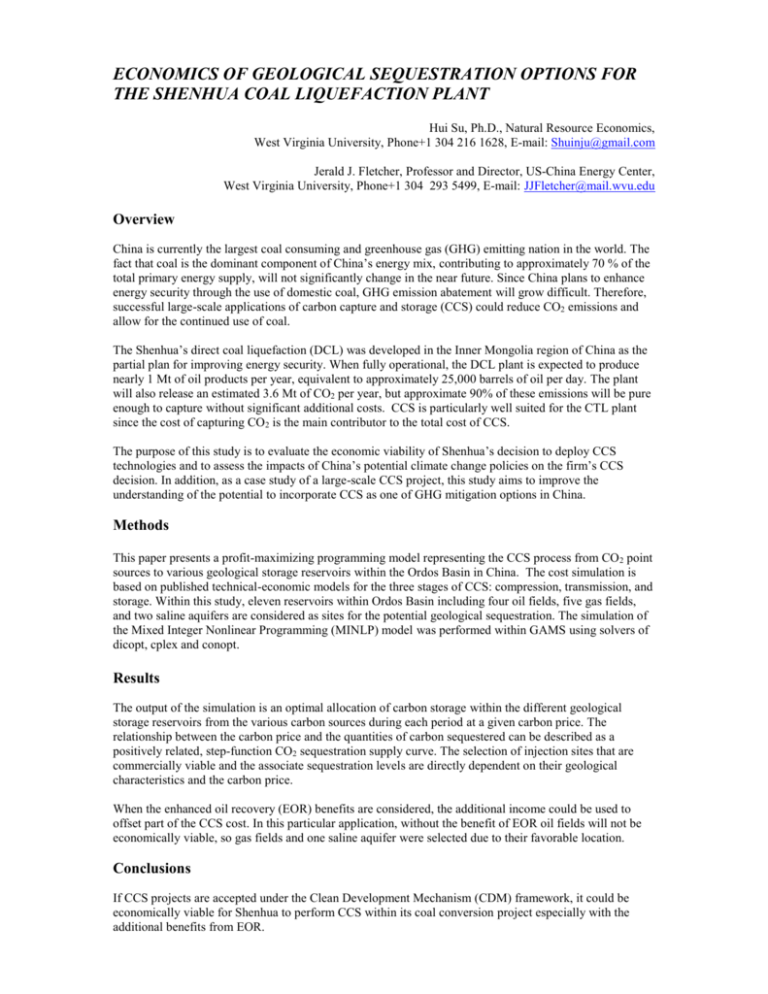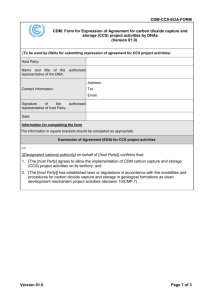Title , description of the topic, reasons why the topic is timely and of
advertisement

ECONOMICS OF GEOLOGICAL SEQUESTRATION OPTIONS FOR THE SHENHUA COAL LIQUEFACTION PLANT Hui Su, Ph.D., Natural Resource Economics, West Virginia University, Phone+1 304 216 1628, E-mail: Shuinju@gmail.com Jerald J. Fletcher, Professor and Director, US-China Energy Center, West Virginia University, Phone+1 304 293 5499, E-mail: JJFletcher@mail.wvu.edu Overview China is currently the largest coal consuming and greenhouse gas (GHG) emitting nation in the world. The fact that coal is the dominant component of China’s energy mix, contributing to approximately 70 % of the total primary energy supply, will not significantly change in the near future. Since China plans to enhance energy security through the use of domestic coal, GHG emission abatement will grow difficult. Therefore, successful large-scale applications of carbon capture and storage (CCS) could reduce CO2 emissions and allow for the continued use of coal. The Shenhua’s direct coal liquefaction (DCL) was developed in the Inner Mongolia region of China as the partial plan for improving energy security. When fully operational, the DCL plant is expected to produce nearly 1 Mt of oil products per year, equivalent to approximately 25,000 barrels of oil per day. The plant will also release an estimated 3.6 Mt of CO2 per year, but approximate 90% of these emissions will be pure enough to capture without significant additional costs. CCS is particularly well suited for the CTL plant since the cost of capturing CO2 is the main contributor to the total cost of CCS. The purpose of this study is to evaluate the economic viability of Shenhua’s decision to deploy CCS technologies and to assess the impacts of China’s potential climate change policies on the firm’s CCS decision. In addition, as a case study of a large-scale CCS project, this study aims to improve the understanding of the potential to incorporate CCS as one of GHG mitigation options in China. Methods This paper presents a profit-maximizing programming model representing the CCS process from CO 2 point sources to various geological storage reservoirs within the Ordos Basin in China. The cost simulation is based on published technical-economic models for the three stages of CCS: compression, transmission, and storage. Within this study, eleven reservoirs within Ordos Basin including four oil fields, five gas fields, and two saline aquifers are considered as sites for the potential geological sequestration. The simulation of the Mixed Integer Nonlinear Programming (MINLP) model was performed within GAMS using solvers of dicopt, cplex and conopt. Results The output of the simulation is an optimal allocation of carbon storage within the different geological storage reservoirs from the various carbon sources during each period at a given carbon price. The relationship between the carbon price and the quantities of carbon sequestered can be described as a positively related, step-function CO2 sequestration supply curve. The selection of injection sites that are commercially viable and the associate sequestration levels are directly dependent on their geological characteristics and the carbon price. When the enhanced oil recovery (EOR) benefits are considered, the additional income could be used to offset part of the CCS cost. In this particular application, without the benefit of EOR oil fields will not be economically viable, so gas fields and one saline aquifer were selected due to their favorable location. Conclusions If CCS projects are accepted under the Clean Development Mechanism (CDM) framework, it could be economically viable for Shenhua to perform CCS within its coal conversion project especially with the additional benefits from EOR. The economic viability of Shenhua’s CCS project demonstrates the potential for successful CO2 sequestration related to coal liquefaction and gasification production and could facilitate a continued growth of the coal gasification and liquefaction industry in China. In terms of policy implications for macro-level carbon management, both incentive and restrictive policies from the government in the future would greatly affect the deployment and development of CCS projects. References Allinson, W.G., D.N. Nguyen, and J. Bradshaw. 2003. "The Economics of Geological Storage of CO2 in Australia." Australian Peteoleum Production & Exploration Association (APPEA) Journal 43: 623-36. Anderson, S. and R. Newell. 2004. "Prospects for Carbon Capture and Storage Technologies." Annual Review of the Environment and Resources 29: 109-42. Bock, B.R., R.G. Rhudy, H. J. Herzog, M. Klett, J. Davison, DGDLT Ugarte, and D. Simbeck. 2003. "Economic Evaluation of CO2 Storage and Sink Enhancement Options." Tennessee Valley Authority (US). Friedmann, S.J., J.J. Dooley, H. Held, and E. Ottmar. 2006. "The Low Cost of Geological Assessment for Underground CO2 Storage: Policy and Economic Implication." Energy Conversion and Management, 47(13-14):1894-1901. International Energy Agency (IEA). 2005. "Building the Cost Curves for CO2 Storage: European Sector." Cheltenham, UK: IEA Greenhouse Gas R&D Programme. ———. "Building the Cost Curves for CO2 Storage: North America." 2005. Cheltenham, UK: IEA Greenhouse Gas R&D Programme. IPCC. IPCC Special Report on Carbon Dioxide Capture and Storage. 2005. Cambridge, UK and New York, NY, USA: Cambridge University Press. Kim, S.H. and J.A. Edmonds. 2000. "Potential for Advanced Carbon Capture and Sequestration Technologies in a Climate Constrained World." In Pacific Northwest National Lab report. Washington, DC. McCollum, D.L. and J.M. Ogden. 2006. "Techno-Economic Models for Carbon Dioxide Compression, Transport, and Storage & Correlations for Estimating Carbon Dioxide Density and Viscosity." Davis, California: Institute of Transportation Studies, University of California, Davis. Meng, K.C., R.H. Williams, and M.A. Celia. 2007. "Opportunities for Low-Cost CO2 Storage Demonstration Projects in China." Energy Policy 35(4): 2368-78. Morse, R.K., R. Varun, and G. He. 2009. "The Real Drivers of Carbon Capture and Storage in China and Implications for Climate Policy." Program on Energy and Sustainable Development Working Paper #88. Otto, V.M. and J. Reilly. 2008. "Directed Technical Change and the Adoption of CO2 Abatement Technology: The Case of CO2 Capture and Storage." Energy Economics 30(6): 2879-98. US-China Energy Center. 2009. Carbon Capture and Sequestration Options for the Shenhua Direct Coal Liquefaction Plant: Final Pre-feasibility Study Report. National Research Center for Coal and Energy, West Virginia University, Morgantown, WV 26056-6064, June, 109 pgs. Su, H., and J.J. Fletcher. 2010. "Carbon Capture and Storage in China: Options for the Shenhua Direct Coal Liquefaction Plant," IAEE Energy Forum, Second Quarter, pp 29-31.






